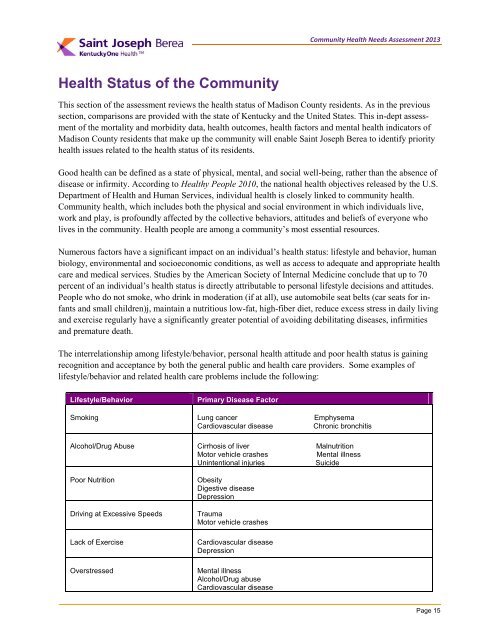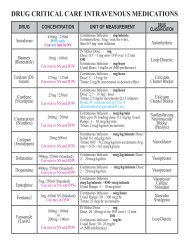Community Health Needs Assessment 2012 - Saint Joseph Hospital
Community Health Needs Assessment 2012 - Saint Joseph Hospital
Community Health Needs Assessment 2012 - Saint Joseph Hospital
You also want an ePaper? Increase the reach of your titles
YUMPU automatically turns print PDFs into web optimized ePapers that Google loves.
<strong>Community</strong> <strong>Health</strong> <strong>Needs</strong> <strong>Assessment</strong> 2013<br />
<strong>Health</strong> Status of the <strong>Community</strong><br />
This section of the assessment reviews the health status of Madison County residents. As in the previous<br />
section, comparisons are provided with the state of Kentucky and the United States. This in-dept assessment<br />
of the mortality and morbidity data, health outcomes, health factors and mental health indicators of<br />
Madison County residents that make up the community will enable <strong>Saint</strong> <strong>Joseph</strong> Berea to identify priority<br />
health issues related to the health status of its residents.<br />
Good health can be defined as a state of physical, mental, and social well-being, rather than the absence of<br />
disease or infirmity. According to <strong>Health</strong>y People 2010, the national health objectives released by the U.S.<br />
Department of <strong>Health</strong> and Human Services, individual health is closely linked to community health.<br />
<strong>Community</strong> health, which includes both the physical and social environment in which individuals live,<br />
work and play, is profoundly affected by the collective behaviors, attitudes and beliefs of everyone who<br />
lives in the community. <strong>Health</strong> people are among a community’s most essential resources.<br />
Numerous factors have a significant impact on an individual’s health status: lifestyle and behavior, human<br />
biology, environmental and socioeconomic conditions, as well as access to adequate and appropriate health<br />
care and medical services. Studies by the American Society of Internal Medicine conclude that up to 70<br />
percent of an individual’s health status is directly attributable to personal lifestyle decisions and attitudes.<br />
People who do not smoke, who drink in moderation (if at all), use automobile seat belts (car seats for infants<br />
and small children)j, maintain a nutritious low-fat, high-fiber diet, reduce excess stress in daily living<br />
and exercise regularly have a significantly greater potential of avoiding debilitating diseases, infirmities<br />
and premature death.<br />
The interrelationship among lifestyle/behavior, personal health attitude and poor health status is gaining<br />
recognition and acceptance by both the general public and health care providers. Some examples of<br />
lifestyle/behavior and related health care problems include the following:<br />
Lifestyle/Behavior<br />
Primary Disease Factor<br />
Smoking Lung cancer Emphysema<br />
Cardiovascular disease<br />
Chronic bronchitis<br />
Alcohol/Drug Abuse Cirrhosis of liver Malnutrition<br />
Motor vehicle crashes<br />
Mental illness<br />
Unintentional injuries<br />
Suicide<br />
Poor Nutrition<br />
Driving at Excessive Speeds<br />
Lack of Exercise<br />
Overstressed<br />
Obesity<br />
Digestive disease<br />
Depression<br />
Trauma<br />
Motor vehicle crashes<br />
Cardiovascular disease<br />
Depression<br />
Mental illness<br />
Alcohol/Drug abuse<br />
Cardiovascular disease<br />
Page 15

















